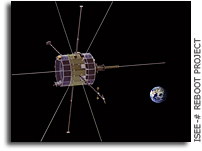ISEE-3 Reboot Project Seeks Your Technical Help
 ISEE-3 Reboot Project Seeks Your Help To Solve a Technical Problem
ISEE-3 Reboot Project Seeks Your Help To Solve a Technical Problem
“We have a crowdsourced research project for our ISEE-3 Reboot fans. One of our volunteers, Karl-Max Wagner from Germany has an interesting idea. Did the Nitrogen pressurizing gas dissolve in the Hydrazine in the tanks?”
Update: We spent all day yesterday with space propulsion experts. We have identified a series of options including hydrazine tank heating and a long series of pulse attempts to (possibly) clear the lines. We have most certainly not given up on this spacecraft yet. It is doing science and will continue to do so for years to come.




Did ISEE-3 not use propellant tanks with diaphragms? If they did use diaphragms, perhaps they failed?
nope…
So, the implication is that if you can heat the hydrazine, you may be able to get the nitrogen to leave solution and thereby repressurize the tank? (assuming that it has gone into solution)
There are some other scenarios that we are looking at now…
I was thinking vaporize some of the Hydrazine but the solar incident heat cant get to the tanks and are not the tanks inside the spacecraft?
Nope, the propulsion system is isolated from the rest of the spacecraft, as are the solar arrays. This was a very special spacecraft.
Long term radiation exposure has increased the penetration of the hydrazine into the metal grains of the Shell 405 catalyst? Its been out there a long time and the formulation is only able to inhibit and not prevent that eventual breakdown. Perhaps they were exposed more in their location comparative to other long-term locations on other spacecraft. As simple as a piece of mylar one way or the other could actually make a difference.
The valves in the thrusters isolate the hydrazine from the catalyst.
By far the most common problem area with hydrazine RCS systems is the valves, either deterioration of the valve seats or blockage of valves with foreign material. Repeated cycling of the valves may resolve the problem. The catalyst might also have deteriorated but it apparently worked for the spin-up burns.
Is the temperature of the hydrazine tank readible by telemetry? Depending on shadowing, partial freezing of the propellant is a possibility even in earth orbit. Heating would actually increase nitrogen solubility, but it’s so low anyway that it would not make a significant difference, and any nitrogen that could dissolve in the hydrazine would do so when the tank was first pressurized. Heating would increase vapor pressure, which may help the situation.
http://research.siri.org/nh…
Actually, we know that the thruster valves and the isolation valves are in good shape due to the pressure in the lines.
I think you are on the right track with short ullage bursts.